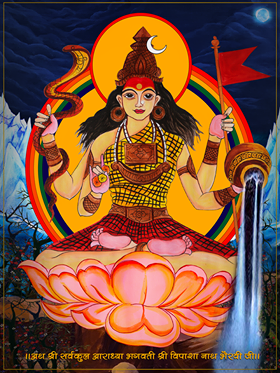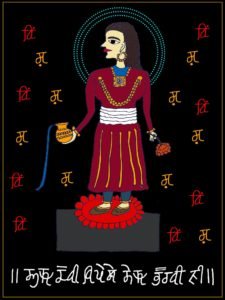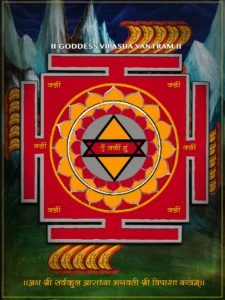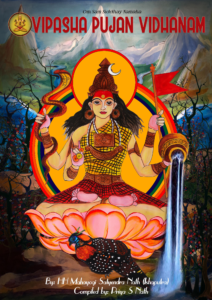Vyasa (Sanskrit: व्यास,) or Vipasha (Sanskrit: विपाशा, literally “Unbound”) is a holy river which originates in the Himalayas of central Himachal Pradesh, India and flows roughly 470 km and merges in Sutlej river when in the state of Punjab, India. It is also commonly referred as Beas, Vyasa River.
Etymology
Etymologically, in ‘Vipasha” (विपाशा), the letter (वि) is prefixed to pasa (पाश). Pasa (पाश) means bondage. So, the amalgamation of both words infers that Vipasha River frees one from all the bondages. It is a river that is blessed with the ability to free anyone from all kind of bondages.
History and origin
Historically, the river was also known as Arjikuja of the Vedas, or Vipasha to the ancient Indians, and the Hyphasis to the Ancient Greeks
As per the ‘Siddha Dharma’, its origin can be traced to Lord Shiva himself in the form of Swatantra or Swachhanda Bhairava and Ma Parvati as Ma Kurukulla. The river is believed to be the outcome of the Laas Nritya of Ma Kurukulla with her Yoginis and Swachanda Bhairava, where he is believed to be a silent participator.
The ‘legends’ of the ‘Siddha Dharma’ reveals that once when in Devadesha, yoginis in Kulluta Mandala, were dancing with Goddess Kurukulla as lead dancer, guiding the dance movements of all Yoginis, Lord Shiva in his form of Svatantra Bhairava or Svachhanda Bhairava arrives in Kulluta Mandala and observes the dance of Kurukulla and all the Yoginis. Bhairava then in a light-hearted play with Goddess, restricts or binds the dance of the goddess and her attendees in a circular trajectory with his mantra. The Goddess thus trapped in Bhairava’s mantra alongside all Yoginis, were then transported to a mountain top in Kulluta Mandala.
The play between Goddess Kurukulla and her Bhairava results in the Goddess dancing alongside her Yoginis to get established in a mandala in Kulluta mountain top. Swachchhanda Bhairava thus challenges the goddess to dance after binding the Goddess with her retinue of Yoginis.
While the playful pastime of god and goddesses were going on in Kulluta Mandala, a Maharishi, Devarishi Vyasa Nath was coming to Himalaya to undertake extreme penance. When Mahasiddha Vyasa Nath was approaching Himalaya, Lord Shiva, Kurukulla and the yoginis notice him and they become invisible. But Yoginis and Goddess Kurukulla, remained trapped in the mantra of Bhairava.
Mahasiddha Vyasa Nath, who was hungry and thirsty was exhausted due to strenuous Himalayan journey. He then sat down due to fatigue on a hilltop and then be begun to wonder. He then contemplated that despite him being very much accomplished in Dharma, authoring several scriptures, Vedas and Purana but one thing he truly lacked was liberation. Thus, contemplating about Mukti or liberation Mahasiddha Vyasa Nath rested a while on the hill.
Saddened by his apparent bonds of human existence, traps of human emotions and thoughts, Devarishi Vyasa desired a Shakti or power which could free him from these bondages of humanness. At that instance, there occurred a celestial announcement. The Yoginis who became invisible upon seeing Mahasiddha Vyasa Nath, together asked him which bond he wants to free himself from. He then replied that he wanted to be free from all kinds of bonds of existence.
The Yoginis then replied to him that it was not difficult for him to attain liberation. The only thing he should first do is to himself free him from the bonds of intellect along with the known eight bondages (hate, shame, fear, doubt, reproach, tradition & modesty). Yoginis further informs him that there exists a goddess who frees one from these eight snares and bondage of intellect. When the Yoginis finished their explanations, Goddess Kurukulla’s laughter is then heard by Yoginis and Mahasiddha Vyasa Nath.
He then enquires with the Yoginis about the laughter. Yoginis inform him that the laughter is of Ma Kurukulla, the supreme leader of Dakinis. Upon further inquiry of Vyasa about Kurukulla, Yoginis reveal that Kurukulla is the goddess who frees one from all kinds of bondages. Yogini asks the Mahasiddhato call her Vipasha .
He then started praying to Goddess Kurukulla calling her Vipasha. But even after her stuti, adulations prayers by Vyasa, she remains invisible. Mahasiddha Vyasa Nath then says to the goddess that he can hear her but he can’t see her. Yoginis then jokingly said that their presiding deity, Goddess Yogamaya, who shall free you from all the bonds is herself trapped. Mahasiddha Vyasa expresses his surprise as how could the Goddess who is Vipasha frees everyone from bonds but she herself is trapped?
Then Goddess Kurukulla laughingly replies to Rishi that she is trapped out of her love for Shiva. That if it wasn’t for her love for Lord Shiva Bhairava, she would have never been in any bond and would have been unfettered.
While this conversation was going on between the celestial goddesses and Mahasiddha Vyasa, he falls down to the ground out of exhaustion and severe dehydration. He then prays to the goddesses for water.
Yoginis seeing the condition of Rishi Vyasa, out of compassion brings water for Vyasa but Vyasa refused to take water from them. Rishi Vyasa asserts that he will accept water only from the Goddess Vipasha who will free him from all bondages. Rishi Vyasa thus began singing praises and stuti of the Goddess while still on the ground. Watching this devotion, Kurukulla tells her Bhairava, Lord Shiva that she will have to break free from his trap. Saying this Kurukulla breaks the trap put in place by Lord Shiva. In later tantra scriptures, this incident is often shown as the reason for goddess being called Vipasha .
After breaking the trap of Shiva, Goddess Kurukulla manifests herself in front of Rishi Vyasa holding a pot of water. The parched Rishi thus partakes the divine water offered by Goddess Kurukulla. Mahasiddha Vyasa then experiences he himself becoming free from all worldly bondages while drinking the water.He then saves some water in his palm. He then drops it on the earth and from it, a lake is formed which is famous today as Vyasa Kunda. Goddess Kurukulla asks Vyasa why he saved the water which she gave to him.
While explaining the reasons, Rishi Vyasa requests the Goddess that her compassionate blessing should reach everyone and not just him. Thus, Rishi Vyasa explains that he dropped the saved water on the ground because he desires to sit beside the newly formed lake and do penance to guide the world on the path of liberation. Rishi Vyasa again requests the goddess to make herself available for the whole world and people desiring Mukti.
The Goddess became pleased by the altruistic nature of Mahasiddha Vyasa Nath. She then proclaims that because of his intention of the welfare of the world, Vipasha, her energies in the form of water will flow and will also be known by the Rishi’s name in future. Esoterically, Vipasha thus prophesized about Vipasha River being known as Vyasa River in future.
Vyasa River and relevance in Kali Yuga
As per the ‘Siddha Dharma’, the main significance of Vyasa River in the day and age of Kali Yuga is its welfare of the future Siddhas. This river is believed to be blessed in the age of Kali Yuga to aid future Siddhas in their path of Dharma.
The legend of ‘Siddha Dharma’ says that when Mahasiddha Vyasa Nath let the water flow from his hand and the water became Vyasa River then the Siddhas and ‘athara karodu’ group of Devi/Devta manifested on the banks of the Vyasa River and started worshipping Ma Kurukulla as Vipasha. Different Rishi/Munis like Mahasiddha Vashistha Nath, Mahasiddha Parashara Nath etc and Yaksha, Kinnar, Bhoot, Gandharva etc also manifested and started singing hymns and worshipping the Vyasa river as they were very ecstatic seeing the manifestation form of Devi flow.
They all in one single voice prayed to the Devi that the Kali Yuga is approaching in a very rapid pace and the Devi should find a way to ensure the liberation of sentient beings in extreme Kali Yuga phase. The Devi then in a very pleased mood ensured all of them that she shall be present in her physical form in the manifestation of the River itself and in her subtle form; she shall reside in the hills and mountains of Kulluta Mandala and impart wisdoms to the future Siddhas and sentient being. She further ensured that in the physical form of water, she shall quench both the physical and spiritual thirst of the future Siddhas. She also further ensured that one who meditates in the banks of her river, they shall excel in bhakti and will also be Siddhas.
She further ensured that she shall flow down with Parvati River and Teerthan River and they shall all confluence in the society so that there shall be some chosen places and spots which shall serve as the main sacred spots for spiritual works in the future.
Sacred spots and sites of Vipasha River
Even though Goddess Vipasha or Kurukulla is worshipped all throughout the course of the divine river Vyasa or Vipasha , but in Siddha Dharma, worship and arti of Goddess Vipasha are recommended at specific places in the courses of the river. Apart from the origin place at the Vyasa Kunda, worship of Vipasha is prescribed in Vashistha, Manali. Then the third place of worship of Vipasha is near Bhootnath temple of Kullu as It is at this point Kaulantak Peeth and Jalandhar Peeth is separated. The confluence of Parvati River and Vyasa River in Bhuntar which is the other side of Larji, is considered auspicious for worship of Vipasha.
For special worship of Vipasha Ji, the final sacred spot is of Larji which lies on the confluence of three rivers.
In Larji, Tirthan River which contains the sacred water from Hanskunda, meets Vipasha. Since Hanskunda water is believed to free one from all curses, the importance of this triveni- the sacred confluence of three streams, is very significant. It has been traditionally used as the sacred place to offer ashes of the dead. It is believed that one attains liberation by offering the ashes at this sacred spot.Spiritual significance of Vyasa River and its tributaries (Tirthan, Parvati)
Spiritual significance
Geographically, Vyasa River originates from Vyasa Kunda and then flows down from Kulluta Mandala to the society; the Tirthan River flows down from the area of Hanskund down to the society and Parvati from Mantalai to the society. The three rivers then confluences at the sacred spot Larji.
But from the perspective of ‘Siddha Dharma’, the three rivers are not just river but three different forms of Shakti. The Teerthan river is the Mahasaraswati form as it flows down from Hanskund which is the area of Satwa and of Lord Brahma ji, the Vyasa river is the form of maha rajasik shakti Devi Kurukulla and the Parvati River is the form of tamas shakti because it flows down from Kulluta Mandala passing the Raktisar area, the area of Mahakali to the society. All the three rivers confluence at Larji and then all three rivers becomes one i.e. Vyasa river.
The confluence of three rivers symbolically means that the area Larji is the place which is considered to be a very holy and auspicious site for all dharmik and sadhana related works. The ‘Siddha Dharma’ treats Larji as one of the most auspicious site in the world. It is also believed that any dharmik work performed here yields results threefold because of the confluence of three Mahashaktis.
The origin of Tirthan River and confluence with Vyasa River
As Per ‘Siddha Dharma’, the goddess Ganga residing in the kamandalu of Lord Brahma became very enthusiast about going to Kulluta Mandala and then participating in the divine plays of Swachandda Bhairava and Ma Kurukulla, their associates in the Deva Desham. She then asked for Lord Brahma’s permission which Lord Brahma refused because as per him, it was not the right time for Ganga to visit the earth. He explained to her that soon when the right time comes she shall be going to the Deva Desham and there she shall be established as a form of the Ganga of Himalaya which would be the center for destruction of sins.
As time passed, four gods were cursed and they had to please lord Brahma ji for freedom from their curses. They the travelled to the area of Brahma ji and then they managed to please him. Lord Brahma told the gods that he shall pour a drop of the water of Ganga from his Kamandalu to the Deva Desham and the area where the water shall fall will be like a small pond and from there the water shall mix into the river which shall be called as Tirthan.
The four gods searched it and located the place. The water that was produced from the pond then mixed with Tirthan River and then the water ultimately mixed with the Vipasha River signifying the confluence of not just two rivers but two Gangas. The Vyasa River was then taken to be the river of salvation and whoever finds the roots of Vyasa Rivers find the roots of one’s own existence and then gets liberated from the world.
Mahasiddha Ishaputra and Vipasha River
His Holiness, Kaulantak Peethadhishwara Mahayogi Satyendra Nath Ji Maharaja (Ishaputra) was also born in Larji. Therefore, for ‘Siddha Dharma’ this site has special relevance and auspiciousness. He was born near the confluence point of the three rivers.
It could be a sheer coincidence or a well written fate, Mahasiddha Ishaputra was born in the confluence point of all the three rivers therefore when he later became the head of Kaulantak Peeth or Kaulantak Peethadhishwara, he became the master of all three Mahashaktis. He became the head of all the Kulas of the three Mahashakti
Vyasa River and Kaulantak Peeth territory
As per ‘Siddha Dharma’, Vyasa River is one of the rivers that separated the Kaulantak Peeth territory with the territory of Jalandhara Peeth and Tibet area. To enter into the area of Kaulantak Peeth, there are 21 invisible doors. The invisible doors can only be reached when one crosses the Vyasa River. The area enclosed by Vyasa River is called Kullu and it is the place from where the physical Kaulantak Peeth starts.
The Tirthan River is the river that separates Jallandhar Peeth with Kaulantak Peeth. The area northern to the Tirthan River is Kaulantak Peeth. The two banks of Tirthan River are Kaulantak Peeth and Jalandhar Peeth. One can also access the invisible door of Kaulantak Peeth by first crossing the Tirthan river and then into the hills of Kaulantak Peeth.
Similar is with with the Parvati River. There are also some hidden doors that can be accessed by crossing the Parvati River into the area of Manikaran. The area beyond the Manikaran is also Kaulantak Peeth and is also referred to as ‘Siddha Bhoomi’.
The Vyasa, Tirthan and Parvati River are the three rivers which also separate the territory for Satwa, Rajas and Tamas sadhanas within Kulluta Mandala. The Tirthan River enclosed area is the area where satwik sadhanas are performed, in the area enclosed by Vyasa River, Rajasic sadhanas are performed while as in the Parvati River enclosed areas especially the Raktisar, tamasic sadhanas are performed.
All in all, the ‘Kaulantak Peeth’ is the spiritual place where all wisdom forms like Yoga, Tantra, Ayurveda, Yuddhakala, Karmakanda, Chikitsa etc are taught and imparted. The satwa, rajas and tamas area of Kulluta Mandala also signifies that Kaulantak Peeth did not discriminate between satwik and tamasic sadhanas. The Peeth is also the place for both Dakshina and Vama Marga.
Furthermore, there is also a text ‘Kaulantak Peeth Mahatamya’ which has mentions of Vyasa River.
अथातः संप्रवक्ष्यामि कुलांतं पीठमुत्तमम ।
यत्पीठं समाश्रित्य मुनयो सिद्धिमागताः ।।
अर्जुनस्य प्रसादाय दाधार शवरं वपु: ।
विपाशा च नदी यत्र नदी च यत्र पार्वती ।।
(कुलांतपीठ महात्म्यम 1/3,4)
“Now I will explain the best Peeth of all the Peeth Kaulanta Peeth. The Peeth, under which Sages took shelter and achieved perfection. To delight Arjuna ,lord Shiva took the avatara of the nomad jungle tribe in this peeth. The place where Vipasha and Parvati river flows.”
“जलन्धरस्य शैचान्ये हेमकूटस्य दक्षिणे !
दशयोजन विस्तीर्ण योजनत्रयविस्तृम् !!
उत्तरे व्यास तीर्थश्च दक्षिणे बंधुको गिरि: !
विपाश पश्चिमे भागे पूर्वे पशुपतिः स्वयम् !
अधिष्ठातृ च शबरी इन्द्रकीलम् पर्वतम् !!”
“At present it is located at north east of Jallandhar Peeth and southern area of Hemkut Mountain. The holy place of Vyasa is in its north, Bandhan Mountain in its south. The holy Vyasa River flows at the western part and Pashupati is in the east. The presiding deity is the Goddess Shabari and its most important mountain is the Indrakilam Mountain”.
Vyasa River and defeat of Alexander Empire
The history of western society believes that ‘Alexander the great’ with his relentless pursuit of expansion of his kingdom reached the Punjab province of Bharata. He then for the first time in his life faced the soldier’s mutiny. The soldiers mutinied and were reluctant to cross the Vyasa River as they had lost all the desires for expansion of the territory of Alexander the great. It was Vyasa River that made Alexander taste the venom of defeat from his own troops.
But ‘Siddha Dharma’ believes that the troops of Alexander the great mutinied because the area across the Vyasa River which he was heading to cross was Kulluta Mandala. The territories strongly were ruled by gods and goddesses and they didn’t welcome Alexander the great. It was the Greek troops who were in the opposition of the gods and goddesses of the Kulluta Mandala. The spiritual powers of the gods and goddesses subjugated all the desires of the troops so therefore they mutinied because crossing the Vipasha River was a child play for the Greeks but not their own inner subjugation.
Alexander the great couldn’t conquer India because of the powers of the Kulluta Mandala.
Similar instances were also faced by the Gorkha Kings. The Gorkha kingdom or present day Nepal territory had expanded from Tista in the East to Kangada to the west. Even the Gorkha soldiers couldn’t capture the Kulluta Mandala because the gods and goddesses didn’t consent. Had the Gorkha soldier conquered, the kingdom of Nepal and the Gorkha soldiers would have been more powerful at todays day and age.
Furthermore, the Nepal folklore also believes that gods and goddesses of Kaulantak Peeth have helped them in defeating the British Empire in the war of Sindhuli Gadhi. Nepal is within the area of Kaulantak Peeth. The almighty British were defeated in the war of Sindhuli Gadhi because the folk lores say that it was the Bees which came in swarms and then chased the British away.
The lesser known fact is that the Bees are the manifestation of Yogini Shaktis. As per the folk lores, the British were not attacked by Bees but by the Yogini Shaktis.
The gods and goddesses of Kaulantak Peeth were very strict in protecting their area from foreign interventions.
Vipasha Arati/Stuti by Mahasiddha Ishaputra
In recent times, around 1998, when the head of Kaulantak Peeth, Kaulantak Peeth Peethadheeswar Mahayogi Satyendra Nath Ji Maharaj, also known as Maha Siddha Ishaputra, for his penance and practices, reached this Vyasa Kunda, the divine lake formed due to celestial pastime of Goddesses, then some kids who were also there for camping saw him. They were amazed to see a bright luminous being dressed only in a cloth wrapped around the waist and with some beads hanging on his neck, with a black kamandalu.
The camping kids who were accompanied by their teacher approached Ishaputra and asked about the significance of the place. Then Maha Siddha Ishaputra revealed this story under Siddha Dharma of Vyasa Kunda and yoginis to them. Those kids out of their excitement requested him to further tell stories of the Goddess Vipasha .
Then Ishaputra told them about a stuti of the goddess that he had written. That stuti, praising the Goddess Vipasha is produced here in its English translation.
Vipasha Aarati
।।हे! योग योगेश्वरी, राज राजेश्वरी, बन्ध विमोचिनी नमोस्तुते
हे! व्यास सागरी, मोक्ष दायिनी, पाश नाशिनी नमोस्तुते
देवदेश की अमृतवाहिनी, कुल्लुता पर्वत वासिनी,
आनंदरूपिणी, नादकारिणी, देवभूमि विलासिनी
अमृत जल प्रवाहिका, अनंत निर्झर धारिणी,
पाश विपाशा हरे सकल सब, कारज मंगल कारिणी
सर्प चन्द्रिका धरे देवी, सप्तलोक निवासिनी,
तप तपस्विनी प्रिये देवी, कली कल्मष हारिणि
ऋषि व्यास आदि वन्दिता, तू वेदवाक्य निवासिनी,
मन मोदिनी, चंचला, गौरी, दया क्षमा गुण धारिणी
मनभीति हर, घन मेघ वसना, विद्युत् पताका धारिणी,
जुजुवाहिनी, औषधि रूपा, देवदार श्रृंगारिणी
दुःख हर, सुबुद्धि कर, प्रमाद व्याधि विनाशिनी,
ब्राह्मी प्रज्ञा प्रदायिका, तू मंद मधुर हासिनि
कर पाश मुक्त तू बंधमोचिनी, सत्य धर्म प्रकाशिनि,
तिमिर हर और ज्योति कर, व्यास पाश विनाशिनी
Vipasha Arati
He, Yoga Yogeshwari, Raj Rajeshwari, Bandha Vimocini Namostute
He, Vyaas Sagari, Moksha Daayini, Paas Nasini Namostutue
O Goddess of Yoga & Goddess of Royal Splendor, Salutation to thee who redeems from bondage
O Goddess with abundant blessings of Rishi Vyas, Salutations to thee who gives liberation
Devadesha Ki Amritavahini, Kulluta Parvat Vasini
Anandrupini, Nadkarini, Devbhumi Vilasini
The vehicle of immortal nectar of Devadesh, residing on mountains of Kulluta,
Taking pleasures in indulgences of the land of Gods, thou art embodiment of bliss & resounding cosmic sound
Amrita Jal Pravahika, Ananta Nirjhara Dharini
Pash Vipasha Hare Sakal Sab, Karaj Mangal Karini
Thou art bestow of immortal nectar and holds the never ending fountain,
Thou art the one who makes all work auspicious and frees from all bonds
Sarpa Candrika Dhare Devi, Sapta Loka Nivasini
Tapa Tapasvini Priye Devi, Kali Kalmash Harini
Thou holds serpent and the moon and resides in all seven realms |
Thou are fond of penance and ascetics and frees one from all dark influences
Rishi Vyasa Adi Vandita, Tu Vedvakya Nivasini
Man Modini, Cancala Gauri, Daya Kshama Guna Dharini
Praised by Rishi Vyas, thou reside in each verse of Vedas Thou art beautiful and entices the mind, volatile Gauri who is compassionate and holds such qualities
Manbhiti Hara, Ghana Megha Vasana, Vidhuta Pataka Dharini
Jujuvahini, Aushadhi Rupa, Devdar Srhingarini
Thou takes away all fears of mind, residing in dark dense clouds holding the flag of thunderbolts
Deodar is thy ornaments, Tragopan is thy vehicle & all medicinal herbs are thy forms
Dukha Hara, Subuddhi Kara, Pramada Vyadhi Vinashini
Brahmi Pragya Pradayika, Tu Manda Madhura Hasini
Thou takes away all sufferings and promotes the right intellect and destroys indolence and other obstacles
Thou bestows knowledge of supreme consciousness, O Goddess with mild laughter
kara Pasha Mukta Tu Bandhmocini , Satya Dharma Prakashini
Timir Hara Aur Jyoti Kara , Vyas Pash Vinashini
Please free us from all bondages and shine thy light of Truth
Thou art destroyer of the bondage of Rishi Vyasa & thou art destroyer of all darkness and cause of illumination
Literature : Vipasha Puja Vidhanam
There are many literatures that have mentions of Vipasha Rivers. There are some mentions in Riga Veda, Mahabharata but there isn’t any special literature or book available in the market for the worship of Vipasha River.
The only available literature for Vipasha River is the Siddha Dharma’s “Vipasha Puja Vidhanam’ complied by Ma Priya Nath. The compiled book is based upon the Kaulantak Siddha Parampara and the methods prescribed by Mahasiddha Ishaputra.
The book explicitly mentions the worship Procedure of Vipasha River and its sadhana module. It explicitly explains the correct process for performing the worship.
The book also further prescribes five different mantras of Vipasha, the yantras related to it, the yantra mandala, the avarana pujan, the yagya procedure, aarati module and the 108 names of Vipasha.





